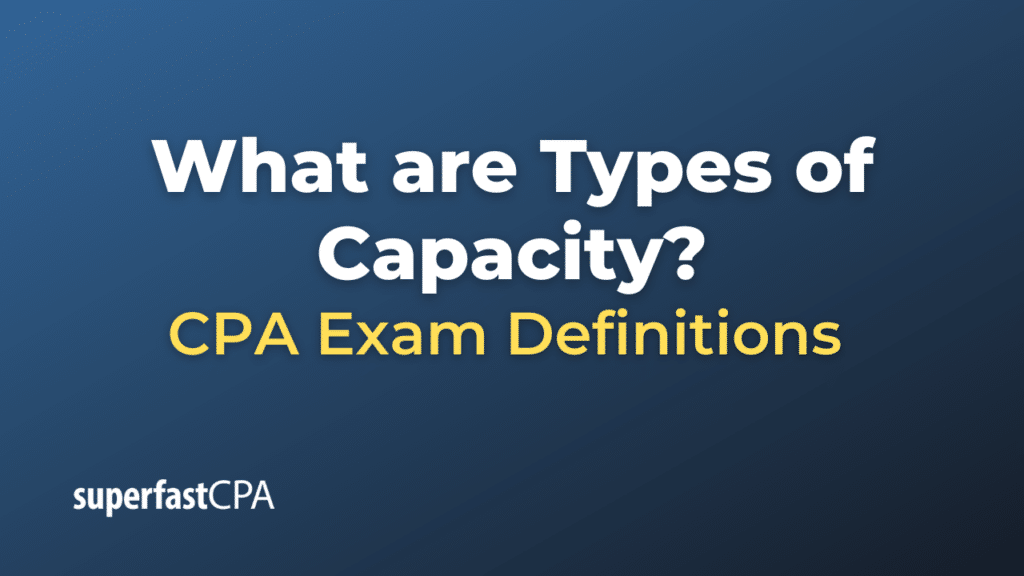Types of Capacity
In the context of operations and production management, “capacity” typically refers to the maximum output that a system can produce within a specified period. Different types of capacity help businesses plan and make informed decisions regarding operations, investments, and resource allocation. Here are some common types of capacity:
- Design Capacity:
- Refers to the maximum output that a system is designed to achieve under ideal conditions.
- For example, a factory might be designed to produce 1,000 units of a product per day.
- Effective Capacity:
- This is the capacity a firm expects to achieve given current operating constraints, like maintenance, breaks, and real-world inefficiencies.
- For instance, while a factory’s design capacity might be 1,000 units per day, its effective capacity could be 800 units due to regular maintenance, worker breaks, and other factors.
- Actual Output:
- Refers to the actual results achieved. It’s often less than effective capacity because of unforeseen disruptions, machine breakdowns, absenteeism, etc.
- For example, the factory may only produce 750 units on a given day due to a machine malfunction.
- Utilization:
- Shows how much of the design capacity is actually being used.
- It’s calculated as (Actual Output / Design Capacity) x 100%.
- Using the above example, utilization would be (750 units / 1,000 units) x 100% = 75%.
- Efficiency:
- Compares the actual output to the effective capacity.
- It’s calculated as (Actual Output / Effective Capacity) x 100%.
- Using the above example, efficiency would be (750 units / 800 units) x 100% = 93.75%.
- Strategic Capacity:
- Bottleneck Capacity:
- This is determined by the process step with the lowest capacity (i.e., the slowest step or the “bottleneck”). The capacity of the entire system cannot be greater than this step’s capacity without making changes.
- For instance, if one machine in a production line can only process 50 items per hour, while all other machines can handle 100 items per hour, the bottleneck capacity is 50 items per hour.
Understanding these different types of capacity helps businesses optimize their operations, plan for the future, manage resources effectively, and meet customer demand. It’s crucial for operational efficiency, cost management, and maintaining competitive advantage.
Example of Types of Capacity
Let’s use a fictional coffee shop, “Bean Bliss,” to illustrate the various types of capacity.
Bean Bliss Coffee Shop:
- Scenario: Bean Bliss is a popular coffee shop downtown. They’re trying to understand their capacity to ensure they can meet customer demands, especially during the morning rush.
1. Design Capacity:
- Bean Bliss has 5 baristas working during peak hours, and theoretically, each barista can make 20 coffees per hour.
- Thus, the shop’s design capacity is 5 baristas x 20 coffees = 100 coffees per hour.
2. Effective Capacity:
- However, considering time taken for customer interaction, payment processing, cleanup, and minor breaks, they estimate each barista can realistically make only 15 coffees per hour.
- This means the shop’s effective capacity is 5 baristas x 15 coffees = 75 coffees per hour.
3. Actual Output:
- On reviewing their sales data, they find that they typically sell around 65 coffees per hour during peak times.
- So, their actual output is 65 coffees per hour.
4. Utilization:
- Utilization = (Actual Output / Design Capacity) x 100%
- For Bean Bliss: (65 coffees / 100 coffees) x 100% = 65% utilization.
5. Efficiency:
- Efficiency = (Actual Output / Effective Capacity) x 100%
- For Bean Bliss: (65 coffees / 75 coffees) x 100% = 86.67% efficiency.
6. Strategic Capacity:
- Bean Bliss analyzes market trends and finds a steady increase in coffee consumption. They forecast a 10% increase in customers over the next year.
- With this in mind, they plan to add more seating space, introduce faster coffee machines, and hire additional baristas to handle the expected rise in demand.
7. Bottleneck Capacity:
- Bean Bliss identifies that the payment process is the slowest, allowing only 10 transactions per barista per hour.
- This bottleneck restricts the number of customers they can serve, even if they can make coffees faster. To address this, they might consider introducing more payment counters or using faster payment technologies.
By understanding and analyzing these different capacities, Bean Bliss can make informed decisions to enhance its operations, ensure customer satisfaction, and remain competitive in the bustling downtown market.












